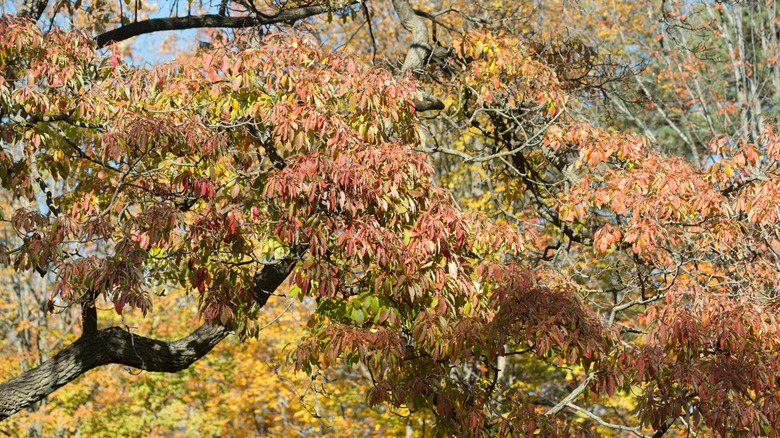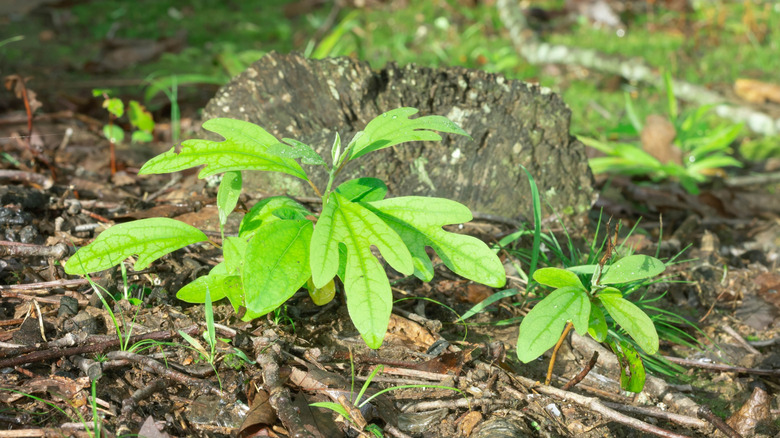The Fragrant Fast-Growing Tree You Can Grow From Seed In Your Own Backyard
You might know Sassafras (Sassafras albidum) as the original root beer flavoring ingredient. While the tree's oil is no longer used to give the beverage its aroma, modern root beer flavor mimics the original taste of the Sassafras-based soda. Even though you can't drink it, the tree with the root beer-like scent still makes a great addition to your garden. It has gorgeous flowers in spring, unique foliage in summer, and vibrant leaf colors in the fall. Even during winter, its reddish brown, ridged bark makes an attractive focal point in your garden while delivering a hint of spicy fragrance.
Because it germinates easily and sprouts quickly, Sassafras is one of the few fast-growing trees you can grow from seeds. In the right conditions in zones 4 through 9, the aromatic tree can grow up to 4 feet per year until it reaches its mature height. Depending on which species you plant and where you situate it, the height could be anywhere from 30 to 115 feet. The only non-extinct species native to the United States, Sassafras albidum typically grows to between 30 and 60 feet tall. The native tree is favored by birds and is a host to multiple species of butterflies. So, if you want to fill your garden with a variety of butterflies, a Sassafras hedge is a great place to start.
Why you should plant a Sassafras tree in your backyard
Whether you want an unusual shade tree that smells like fruit loops and root beer, or are seeking a low maintenance privacy hedge, Sassafras is one of the most attractive trees you could choose. With interesting bark and foliage, beautiful blooms, and impressive fall colors, this hardy tree has something to offer all year round. Sassafras can grow rapidly while spreading up to 40 feet wide via suckers. If you want a more formal specimen or shade tree, you just have to prune the suckers as they emerge from the base of the main trunk. But if you want a fragrant hedge, simply let the tree do its thing and spread out.
In addition to its fragrance and ornamental value, Sassafras is also adaptable to a wide variety of conditions. It prefers moist, well-drained soils with at least partial sun. However, it will tolerate everything from light shade to a soggy growing medium. Once established, the tree can also handle drought and tolerates growing near juglone-producing black walnut.
Because it grows so quickly and in such diverse conditions, Sassafras can become an aggressive spreader. If left to its own devices, it may crowd out other species and continue spreading well beyond the area you initially planted. With that said, controlling its spread can be as simple as mowing suckers around the base of the tree periodically.
How to grow a Sassafras tree from seed
With an 85% average germination rate, it's surprisingly easy to grow Sassafras from seed. The large seeds pack enough nutrients that the Sassafras seedling can do well even in shady spots and poor soils. The key is to sow the seed right where you want the tree to grow. Seedlings will develop a long taproot quickly, and this makes it hard to transplant the tree successfully later. While Sassafras can adapt to just about any environment, you should plant seeds in their preferred conditions to help them grow fast. Your fragrant tree will grow best if you plant it in nutrient-rich, well-drained soil. Its foliage also develops more vibrant fall colors when grown in a sunny location.
Wherever you choose to plant Sassafras, be sure to sow the seeds in the fall and cover them with mulch. While some seeds germinate without cold stratification, most require about 30 to 60 days of cold weather before they sprout in spring. Throughout fall and winter, water often enough to keep the soil consistently moist, but not soggy. As your seedlings start emerging, continue to keep the area mulched and moist while they get established. If you keep conditions right, the seedlings could shoot up as high as 4 feet in their first year and keep up the same rapid growth rate for up to 10 years.


